Frederick Kiesler
Life Visions
15 Jun - 02 Oct 2016
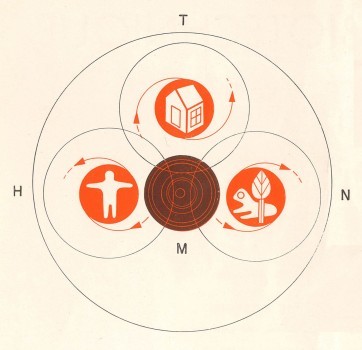
Frederick Kiesler
Man = heredity + environment
diagram for "On Correalism and Biotechnique", illustration in Architectural Record, New York, 1939
Man = heredity + environment
diagram for "On Correalism and Biotechnique", illustration in Architectural Record, New York, 1939
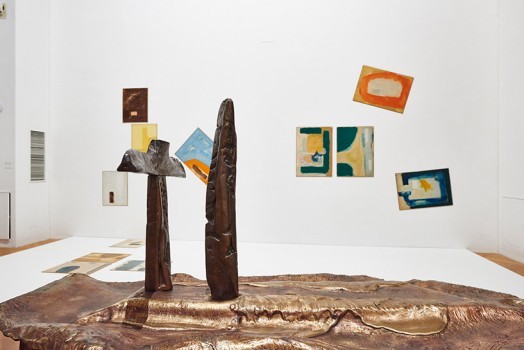
Exhibition view
In the foreground: Frederick Kiesler, Landscape-Marriage of Heaven and Earth, 1961–1964;Belvedere, Vienna, permanent loan from the Austrian Ludwig Foundation, Vienna;MAK Exhibition Hall
In the foreground: Frederick Kiesler, Landscape-Marriage of Heaven and Earth, 1961–1964;Belvedere, Vienna, permanent loan from the Austrian Ludwig Foundation, Vienna;MAK Exhibition Hall

Frederick Kiesler
U. S. Housing in War and Peace, special exhibition in Moscow, study for the exhibition design, New York, 1944
U. S. Housing in War and Peace, special exhibition in Moscow, study for the exhibition design, New York, 1944
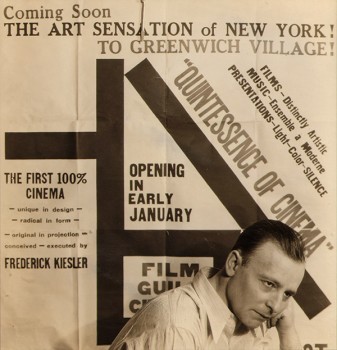
Frederick Kiesler in front of the placard for the opening of the Film Guild Cinema New York, 1929/30
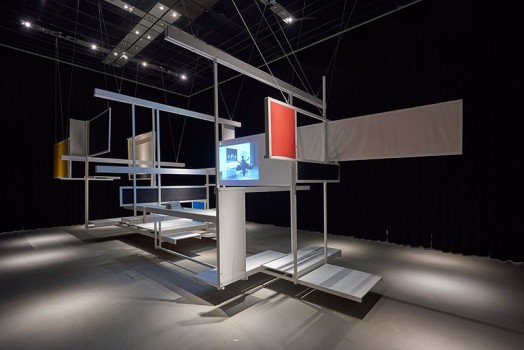
Frederick Kiesler
View of the Raumstadt City in Space Paris, 1925.
Exposition internationale des Arts décoratifs et industriels modernes, Paris
View of the Raumstadt City in Space Paris, 1925.
Exposition internationale des Arts décoratifs et industriels modernes, Paris
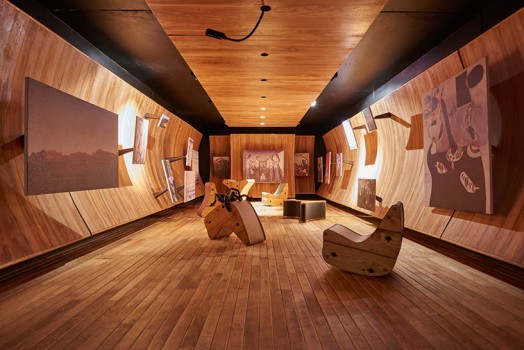
Frederick Kiesler
Art of This Century, 1:3 reconstruction model of the Surrealist Gallery, 1989
Austrian Frederick and Lillian Kiesler Private Foundation;MAK Exhibition Hall
Art of This Century, 1:3 reconstruction model of the Surrealist Gallery, 1989
Austrian Frederick and Lillian Kiesler Private Foundation;MAK Exhibition Hall
FREDERICK KIESLER
Life Visions
15 June – 2 October 2016
Curator: Bärbel Vischer, Curator, MAK Contemporary Art Collection
Guest Curators: Dieter Bogner and Maria Lind
The current interest in the multifaceted oeuvre of the Austrian- American architect, artist, designer, set designer, and theoretician Frederick Kiesler applies most of all to his holistic philosophy—the negation of the traditional boundaries drawn between disciplines—and the importance he ascribed to the productivefusion of artistic and empirical scientific practice. In so doing, he placed the wellbeing of the human, as an individual as well as a social being, at the center of his bioscience-based correalistic theory.
The years Kiesler spent in Vienna surrounded by Otto Wagner, Josef Hoffmann, and Adolf Loos and the idea of the Gesamtkunstwerk were formative for his entire artistic and theoretical body of work. The focus of this evocative exhibition is Kiesler’s transdisciplinary work in painting and sculpture, architecture and design, theater and film, with his theory of Correalism as well as his innovative exhibition practice being put up for discussion. His vision of a correlation between artwork, space, and spectator manifested itself in his revolutionary exhibition designs, just as much as in his Galaxies of the 1950s and 1960s.
On show is a thematic presentation of a large number of visionary sketches, photos, plans, and texts from the extensive inventory of the Austrian Frederick and Lillian Kiesler Private Foundation. These are to be supplemented by items loaned by private collectors and public institutions. For the first time, a 1:1 reconstruction of the Parisian City in Space, one of the most important architectural icons of the 20th century, will be shown in Austria.
The goal of the exhibition is to convey the visionary universe of ideas and its history-shaping potential as an influential contributor to present-day discussions about art, architecture, design, theater, and theory.
Four trenchant pictures convey the cornerstones of his life’s work: the Parisian Raumstadt [City in Space] of 1925 and the model of the Endless House of 1959, which stand for his architectonic visions; the emblematic representation of his anthropocentric theory of Correalism published in 1939; and also a photo showing Kiesler as the “inhabitant” of his monumental wooden Rockefeller Galaxy of 1952. The title of the newspaper article in which he published this photo was “Meant To Be Lived In.” This can be
understood as the guiding principle of the exhibition.
Interventions by six international artists—Leonor Antunes, Céline Condorelli, Verena Dengler, Lili Reynaud-Dewar, Apolonija Šušteršič, and Rirkrit Tiravanija—create a field of tension between contemporary positions and Kiesler’s theoretical and creative concepts presented in the exhibition.
As an integral component of the exhibition, a participative educational program gives leeway to the perspectives of young people. In the course of intensive engagement with Frederick Kiesler’s visionary concept of space, Viennese schoolchildren created contributions that were varied in terms of their content and choice of media.
The exhibition is accompanied by the catalog FRIEDRICH KIESLER: Life Visions, edited by Christoph Thun-Hohenstein, Dieter Bogner, Maria Lind, and Bärbel Vischer, German/english, 224 pages with numerous color illustrations. MAK Vienna/Birkhäuser Verlag, Basel 2016. Available at the MAK Design Shop for € 39.95.
In cooperation with the Austrian Frederick and Lillian Kiesler Private Foundation.
Life Visions
15 June – 2 October 2016
Curator: Bärbel Vischer, Curator, MAK Contemporary Art Collection
Guest Curators: Dieter Bogner and Maria Lind
The current interest in the multifaceted oeuvre of the Austrian- American architect, artist, designer, set designer, and theoretician Frederick Kiesler applies most of all to his holistic philosophy—the negation of the traditional boundaries drawn between disciplines—and the importance he ascribed to the productivefusion of artistic and empirical scientific practice. In so doing, he placed the wellbeing of the human, as an individual as well as a social being, at the center of his bioscience-based correalistic theory.
The years Kiesler spent in Vienna surrounded by Otto Wagner, Josef Hoffmann, and Adolf Loos and the idea of the Gesamtkunstwerk were formative for his entire artistic and theoretical body of work. The focus of this evocative exhibition is Kiesler’s transdisciplinary work in painting and sculpture, architecture and design, theater and film, with his theory of Correalism as well as his innovative exhibition practice being put up for discussion. His vision of a correlation between artwork, space, and spectator manifested itself in his revolutionary exhibition designs, just as much as in his Galaxies of the 1950s and 1960s.
On show is a thematic presentation of a large number of visionary sketches, photos, plans, and texts from the extensive inventory of the Austrian Frederick and Lillian Kiesler Private Foundation. These are to be supplemented by items loaned by private collectors and public institutions. For the first time, a 1:1 reconstruction of the Parisian City in Space, one of the most important architectural icons of the 20th century, will be shown in Austria.
The goal of the exhibition is to convey the visionary universe of ideas and its history-shaping potential as an influential contributor to present-day discussions about art, architecture, design, theater, and theory.
Four trenchant pictures convey the cornerstones of his life’s work: the Parisian Raumstadt [City in Space] of 1925 and the model of the Endless House of 1959, which stand for his architectonic visions; the emblematic representation of his anthropocentric theory of Correalism published in 1939; and also a photo showing Kiesler as the “inhabitant” of his monumental wooden Rockefeller Galaxy of 1952. The title of the newspaper article in which he published this photo was “Meant To Be Lived In.” This can be
understood as the guiding principle of the exhibition.
Interventions by six international artists—Leonor Antunes, Céline Condorelli, Verena Dengler, Lili Reynaud-Dewar, Apolonija Šušteršič, and Rirkrit Tiravanija—create a field of tension between contemporary positions and Kiesler’s theoretical and creative concepts presented in the exhibition.
As an integral component of the exhibition, a participative educational program gives leeway to the perspectives of young people. In the course of intensive engagement with Frederick Kiesler’s visionary concept of space, Viennese schoolchildren created contributions that were varied in terms of their content and choice of media.
The exhibition is accompanied by the catalog FRIEDRICH KIESLER: Life Visions, edited by Christoph Thun-Hohenstein, Dieter Bogner, Maria Lind, and Bärbel Vischer, German/english, 224 pages with numerous color illustrations. MAK Vienna/Birkhäuser Verlag, Basel 2016. Available at the MAK Design Shop for € 39.95.
In cooperation with the Austrian Frederick and Lillian Kiesler Private Foundation.



